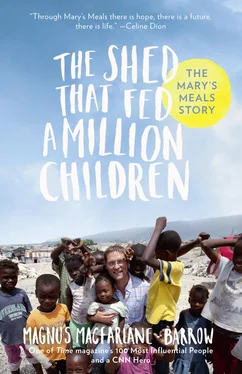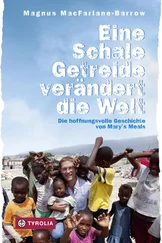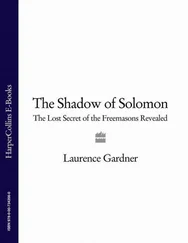In Glasgow, Scotland’s largest city, a wonderful retired couple, John and Anne Boyle, came to our rescue. They set up a volunteer support group in the city, and obtained a free warehouse from the city council as well as a van to carry out local collections. Before long this became the biggest part of our operation. The free warehouse was a very welcome gift but hardly ideal in design. Our space was on the fourth floor, meaning all goods were transported in and out using a very old lift. On the days we loaded the truck for transport overseas, one team would repeatedly fill the lift on the fourth floor, before sending it down to the team below, who carried it out to the truck. More than once the lift broke down. We came to understand that the city authorities would only send out a technician immediately to repair it if there was someone stuck in the lift, otherwise we could be left for hours, or even days, without a way to complete the loading. We eventually discovered we could climb inside the stuck lift, through its roof, and sometimes resorted to doing this prior to phoning the council.
‘Yes, there is someone inside,’ we would answer honestly and accurately. I think probably they had a very good idea what we were up to, when they arrived to find one of us inside, red-faced and squeezed in beside a stack of boxes, but it seemed like they, along with everyone else in the city, just wanted to be part of the effort and keep the aid moving. While, initially, much of our support in Glasgow came through the churches, when the large Muslim community there heard of our work, they became very involved too. They organized collections of food at the mosques on a regular basis and would deliver huge quantities to our stores. Many in this Asian community, mainly of Pakistani descent, were involved in wholesale food retailing and they often donated us their surplus stocks. But we could never get enough dried and tinned food. It was always top of the lists of urgent requests we were being sent from Bosnia-Herzegovina. We began to approach supermarkets and seek their permission to carry out food collections. They would allow us to park an empty shopping trolley at their entrance and hand leaflets to customers entering the store, inviting them to buy an item on our list and deposit it in the trolley on the way out. A small team of us would target a different store every weekend with this approach and the willingness of people to donate this way amazed us. It was efficient, too, as a team in the back of our van would categorize and pack each product separately as it came in. We usually returned to the warehouse late in the evening with full boxes ready to deliver, marked Tinned veg , Pasta , Sugar and so on. Nearly all the boxes we used as packaging were donated by whisky distillers. They were strong boxes, ideal, but could cause huge excitement and consternation at border posts. Customs officials and police would stand open-mouthed when we responded to their requests to open the back of our truck for inspection, their immediate assumption being that these ‘humanitarians’ were actually whisky smugglers. They usually seemed a little disappointed when we opened the boxes to reveal their more mundane contents. As time went on we became aware of another interesting pattern at the supermarket collections. At those in the deprived areas of Glasgow – often housing schemes with some of the worst rates of unemployment and poverty in the UK – we noticed that we would be donated significantly more than at those in the more affluent suburbs. Not something I can pretend to explain the reasons for, but something real and quite marked none the less.
I found ‘giving patterns’ a little harder to predict while doing street collections for money. This was an activity I enjoyed much less than the supermarket collections. Somehow it always seemed harder to ask a stranger for money than for food. Even though it should have been obvious that this was not a personal plea, there was something about rattling a can while saying ‘please help the people of Bosnia-Herzegovina’ I found very difficult. There was a little humiliation involved; perhaps the tiniest taste of what it must feel like to have to beg for your own needs. To pass the long hours on the pavement I would sometimes enter into a private game of guessing the response of each pedestrian as they walked towards my solicitation. The guy with the muscles and tattoos; the woman pushing the pram; the schoolkids on their lunch break; the busker who had looked annoyed by my presence on ‘his patch’. Each one would, more often than not, surprise me. I could not form any conclusions on categories of people and the likelihood of them dropping some coins in my can. And I could not compare and distinguish giving patterns between men and women, young and old, meek-looking and fierce, or the singers of old depressing Scottish songs and upbeat-but-off-key bagpipe players. I am sure others have carried out more scientific experiments in this matter, and could therefore prove me wrong, but I certainly concluded that people of all sorts could be extremely generous and extremely mean. Our experience of this even included the potential of a much more controversial comparison when we were given permission to do a street collection outside the national football stadium before a Scottish Cup Final, which was to be contested by the two giants of Scottish Football, Glasgow Rangers and Glasgow Celtic. Rivalry between these two teams has a reputation for being perhaps the fiercest in world football, representing as they do the Protestant and Catholic communities of the West of Scotland and the rather unsavoury, historical baggage that goes with that. So it was with some trepidation we ventured out with our collecting cans among the swarming fans, approaching the stadium in their tens of thousands. I wondered if they would even notice our presence or hear our invitation. They certainly did and their giving was incredible – the most generous we had seen. I suspect there may have been a competitive element involved. Perhaps they thought we would keep separate totals for amounts donated by fans wearing blue and those wearing green and publish it for the world to see. Or maybe it is just that pre-match beer helps open hearts and wallets. Whatever the reasons (and I am sure in reality they were much more laudable than those I mention), we collected a record total in a very short space of time as the fans entered the stadium. The link with those Glasgow football clubs actually has continued in various ways ever since.
A couple of years after that event I was introduced to two famous former footballers, Frank McGarvey and Gordon Smith, who used to play for Celtic and Rangers respectively. They decided to organize a match between former players of both clubs to raise funds for us. As a Celtic fan myself and a lover of football, I could not have been more excited. They booked a small stadium in the East End of Glasgow and phoned their old friends from both clubs. Many famous players agreed to play. The day before the event I chatted briefly to Frank about some last-minute arrangements. I asked him how his team was shaping up.
‘Not too great, actually,’ he replied. ‘A few have called off at the last minute. You better take your boots along yourself.’
I laughed.
‘No, I’m not joking. Take your boots. You’re a big lad and you told me you could play a bit.’
He hung up. I stopped laughing. Then I phoned around my friends to tell them the news. Then I looked for my old boots, which had not been usefully employed for some time. The next day I found myself sitting in a dressing room with a group of players who had all been boyhood heroes of mine, talking about tactics and how to beat Rangers. I remembered having lots of dreams just exactly like this when I was young. This was very strange indeed.
Читать дальше












